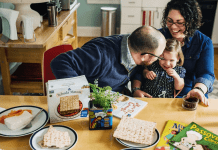My husband and I have walked into my late mother-in-law’s house for the last time.
We are in the process of settling her estate, including the sale of her house and disposition of everything in it.
From a hutch filled with china and crystal goblets to overflowing jewelry boxes and coin collections. And everything in between.
A lot in between.
Her clothes. The Notre Dame sweaters my late father-in-law was so fond of wearing. Her furniture. Furniture inherited from her mother-in-law, still in the same place in the garage where it was originally placed 30 some-odd years ago. My husband’s Cub Scout uniform. Christmas decorations. Lots and lots of Christmas decorations.
Every room, every closet, every shelf, every drawer. Full of stuff. A lifetime of stuff. Two lifetimes, if you count my father-in-law, who passed away 11 years ago.
What to Do With a Lifetime of Stuff
My mother-in-law was a neat and tidy housekeeper. But like many of us (myself included), she lived in a good-sized house with plenty of room to accommodate stuff. Things inherited from her parents and her in-laws. The broken vacuum cleaner waiting for repair in the back of the closet. Hundreds of books read once. You get the picture.
And the cost of disposing of all of that stuff? Having the estate sale company we hired go through every room, every closet, every drawer, separating the trash from the treasures, may cost more than will be generated at the eventual estate sale.
Her house has been transformed into a store, the estate sale company having cleverly arranged and displayed my mother-in-law’s possessions on tables in every room.
All of her possessions with any value, save the very few we kept, each with a tiny white price tag.
Losing your last surviving parent is hard enough. But being the arbiter of which of your parents’ and grandparents’ treasures get saved and which end up sold, donated, or in a landfill? gut-wrenching.
The lesson we have learned from this experience?
Most of the stuff in your house is worthless. And eventually, someone, either you or your kids, will be tasked with the overwhelming job of getting rid of it.
Most of Your Stuff Is Worthless
Most of the stuff in your house is worthless.
Yes, even the stuff you worry the most about, the stuff you think is so good you don’t use it for fear of breaking it, has little to no resale value.
From china, china cabinets, crystal goblets, silver tea sets, pianos, and collectible figurines like Hummels, to grandfather clocks and real pieces of craftsmanship furniture.
Why? Baby boomers have glutted the market with their castoffs, and millennials, the next generation of buyers, don’t want it.
Millennials hate both formal in-home entertaining and use of second-hand goods. With looming student loans, they tend to rent and move often. Who wants to be constantly moving a piano and a grandfather clock from apartment to apartment?
And furniture? There’s no market for so-called “brown furniture,” meaning any furniture (regardless of quality) other than the “mid-century casual” furniture (think clean, lightweight) favored by millennials. Brown furniture is basically firewood.
If it’s not in great condition, it’s also not fit for donation because it can’t be resold.
All of my mother-in-law’s furniture (including the pieces inherited from her mother-in-law and kept for decades)? Straight to the landfill.
Well, Almost Everything…
What do guns, LPs (records), and precious metals/gems have in common?
They are 3 things you might have in your house with a robust resale value.
Silverware also has value, but only if it is real silver and can be melted down.
3 Things You Should Be Doing NOW to Reduce the Amount of Stuff You Have
1. Be viciously thoughtful about holding onto sentimental items.
Here was our goal with sorting through my mother-in-law’s things. Keep just enough to remind us of her, but not so much stuff that our daughters are going to be dealing with it 40 some-odd years from now.
Here’s what we kept:
- A painting to be displayed in our dining room
- My mother-in-law’s treasured Swarovski crystal animal collection (all of which were given to her by her children and grandchildren over the years)
- Jewelry to be divided among the granddaughters
- Each of our daughters got to select 1 item
And that was it.
Well, almost. We did set aside photos to be digitized (with the originals then destroyed).
Was it hard leaving everything else? You bet it was. But we don’t want to be dealing with a lot of stuff years from now (or worse, leaving it to our daughters to deal with).
I try to be viciously thoughtful with my own sentimental items. For example, I don’t save any school papers or art projects from my kids (though I do take photos of my favorites).
2. Buy fewer books.
While used book resellers like Half Price Books do an important service in keeping books in circulation, a surprising number of books end up in landfills because many paper recycling facilities can’t process the the glue that binds book spines.
My resolution last year was to cut down on my book consumption by only reading books that I borrow from the library or purchase on my Kindle e-reader. If you haven’t used a library in years, now is the time to go back. My local library has an app where you can “order” books online, and pick them up the next day on a special “hold” shelf strategically placed next to the check-out kiosk.
How successful was I on my resolution? I read 1 to 2 books a week in 2019, only 1 of which was a hard copy purchased from Amazon.
3. Buy fewer, but better quality, clothes
The world is overflowing with used clothing.
We buy substantially more clothing over our lifetimes than our grandparents did.
Clothing made today is meant to last no more than a few years. In fact, a lot of clothing isn’t even made to withstand more than a few washes.
Think you are “paying it forward” but dropping off a load of unwanted clothes at Goodwill? Think again. Most clothing donations never make it to the racks at Goodwill and only about a third of what does eventually sells.
To really pay it forward, cut down on the amount of clothing you have by buying better quality clothes that last longer.
Keeping What Really Matters
My 5-year-old chose to keep a Christmas music box from her Grandma’s house. It plays “White Christmas” and has tiny ice skaters going around a rink inside. Each Christmas, my mother-in-law would bring out this music box and let each of her granddaughter’s play with it. It’s value in preserving a precious memory of Grandma? Priceless.














Most people my age have lost both parents. Mine lived rent free in a house owned by the church. When dad died, (mom died first) our priest gave us 2 weeks to vacate. Two weeks to completely eradicate 35 years of living! I don’t know how we did it, but somehow we did. The take away from that was, I try at least once a week to get rid of at least ONE item that I know will not be of value to my adult girls.
Don’t ever destroy original copies of photos! If you have the real thing keep it. Technology changes so quickly that even just 10 years from now you may not be able to view the photos you thought you had preserved.
I think in many cases this is true. I made it my practice to use my “best China” for birthday dinners and special events throughout the year. A beautifully dressed table is a tradition that I believe will be carried by my son and daughter in law’ in the future. They like finer things.
I am grateful for all the treasures the generations before have left behind to cherish. I do not care if they are considered of value in the writers world for they are a delight in mine. Items once held in the hands of loved ones over a century ago carry the stories of their lives . The 1930’s print of blue birds from my moms childhood home, my great great paternal grandmother’s steamer trunks with J.C on the sides, It would have been an honor to clean out my moms house if I had been given the opportunity, which in turn would have given closure. Somethings are not meant to be easy (birth death) but a necessary process of life. I love fine old things always have, big ornate “clunky furnishings” Victorian, Edwardian crystal,key wound 1930’s clock, old old books & press back rocker,place setting for 12… I would rather drink from “second hand” fine crystal than trendy but cheaply made over priced objects. The world is filled with garbage and the writer wants to add more? Complete demolition/gutting craftsman homes, mid century moderns to replace with modern materials like fake wood flooring,drywall,white paint on woodwork that too will be in the garbage. It would be vexatious to my spirit to part with these precious objects.
Regarding photos: After you’ve scanned them, donate the originals–with those in the photo identified–to the historical society in the county/city where the people were from. These types of photos are invaluable to those of us trying to piece together our genealogy. Plus–who knows how viable digital storage will be as time goes on. What used to be on a floppy, was then stored on a small flash drive, then a bigger flash drive, then CDs and then DVDs and now in the “cloud.”
I don’t suppose you could have just incorporated some of her things into your own life? This all sounded very heartless.
I enjoyed reading this article and everyone’s comments. The landfills are overflowing now! Yes many people are downsizing and I get that. Some resorting to tiny homes..which are illegal in many ways.. “Schoolies”.. converting school buses into homes..although I get that too, paying off overwhelming student loan debt, medical bills, inability to pay for the “American Dream”.. being a homeowner.. not having money to enjoy and raise their children. Many changes and challenges every generation faces. I grew up in a pre-civil war cabin in Tennessee. One sister says,”Tear it down!” Worthless! She like another sister and parents are gone now. The historical society reps mouths watering and fascinated with the preservation and history.. begging me to have my family home included in their organization and preservation of same. My final two cents worth.. boils down to an all encompassing set of views and values. We are not all the same. We all have our own style and family history and talents and positions in life. My daddy a farmer and history buff…read a book everyday..my mom a school teacher.. my brother a finished carpenter.. runs his hand like butter across a piece of wood…creates winding staircases out of bent wood after process of water and bending.. a lost art form..creates furniture and floors out of reclaimed wood to include barn wood. .my deceased sister hand painted and fired lamp shades to preserve “Gone with the Wind” family heirlooms…sister fine arts oil painter…me a decorator.. collector of antiques..glassware..furniture restorer.. tree hugger and realtor. Deceased youngest sister raised German Shepherd dogs. And so it goes..”One man’s trash.. another man’s treasure”.
While I do agree with many of her ideas I abhor the thought of dumping stuff in the landfill. Brown furniture may not be popular but furniture of that quality will never exist again. Even if one could find a craftsman of that kind the wood itself is impossible to find again. That wood came from old growth trees. It does not exist anymore.
It is absolutely ridiculous and ecologically irresponsible to continue to buy “new”.
Less is more, I get that. But reuse and repurpose. The planet cannot support our throw away habits.
Very good comment. The younger generation does not seem to care about quality, they sadly prefer Ikea junk to a piece that has lasted a hundred years or more. It’s the same with everything now, only made to last a couple years, tools now have parts made of plastic and when they brake, you can’t get replacements or it costs more that replacing the item… such a sad situation
Of course any money, jewelry, sterling silverware and even guns are always welcomed by families I would hire an estate sell company to sell the rest and it is no out of pocket cost to the family. The estate sell company will organize and sell items the family does not want for a 60/ 40 more or less split and arrange to have a charity pick up the rest. I said all this to say no need for additional stress on these sad and somber occasions.
It’s hard to understand why they prefer cheap junk from IKEA to quality, real wood furniture; trendy plastic dishes to bone China, but they do!